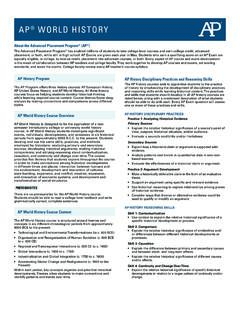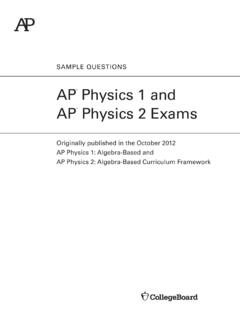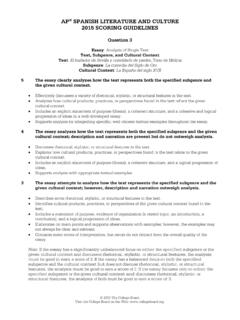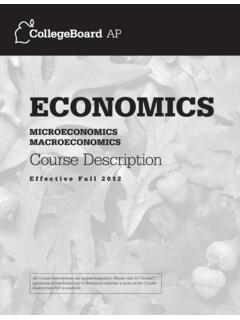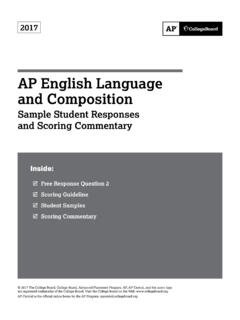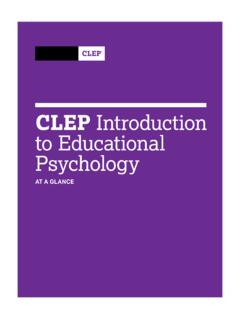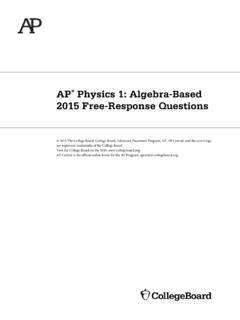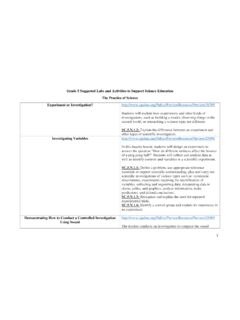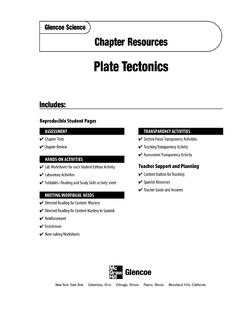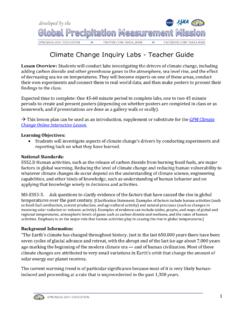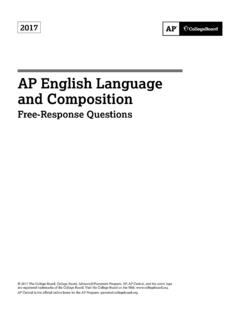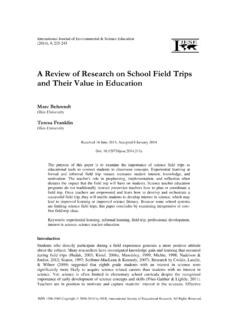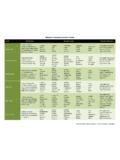Transcription of BACKGROUND - College Board
1 Cellular Processes: Energy and Communication BigIdea 2. investigation 5. PHOTOSYNTHESIS. What factors affect the rate of photosynthesis in living leaves? BACKGROUND . Living systems require free energy and matter to maintain order, to grow, and to reproduce. Energy deficiencies are not only detrimental to individual organisms, but they cause disruptions at the population and ecosystem levels. Organisms employ various strategies that have been conserved through evolution to capture, use, and store free energy. Autotrophic organisms capture free energy from the environment through photosynthesis and chemosynthesis, whereas heterotrophic organisms harvest free energy from carbon compounds produced by other organisms. In multicellular plants, photosynthesis occurs in the chloroplasts within cells. The process of photosynthesis occurs in a series of enzyme-mediated steps that capture light energy to build energy-rich carbohydrates.
2 The process is summarized by the following reaction: 2 H2O + CO2 + light carbohydrate (CH2O) + O2 + H2O. To determine the net rate of photosynthesis, one could measure one of the following: Production of O2. Consumption of CO2. The difficulty related to measuring the production of oxygen is compounded by the complementary process of aerobic respiration consuming oxygen as it is produced. Therefore, measuring oxygen production is equivalent to measuring net photosynthesis. A measurement of respiration in the same system allows one also to estimate the gross production. Generally, the rate of photosynthesis is calculated by measuring the consumption of carbon dioxide. However, equipment and procedures to do this are generally beyond the reach of most introductory laboratories. In Getting Started, students conduct prelab research on the process of photosynthesis and review concepts they may have studied previously particularly concepts about the properties of light.
3 In the first part of the lab, students learn how to measure the rate of photosynthesis indirectly by using the floating leaf disk procedure to measure oxygen production. Alternatively, they could explore how to measure the rate of photosynthesis using various probes interfaced to computers. In the floating leaf disk procedure, a vacuum is used to remove trapped air and infiltrate the interior of plant (leaf) disk samples with a solution containing bicarbonate ions that serve as a carbon source for photosynthesis. The infiltrated leaves sink in the Investigation 5 T95. bicarbonate solution. When placed in sufficient light, the photosynthetic processes then produce oxygen bubbles that change the buoyancy of the disk, eventually causing them to rise. Students should develop the skills necessary to implement the selected procedure so that they can explore their own questions about photosynthesis in Designing and Conducting Your Investigation.
4 Procedure serves as a structured inquiry that is a prerequisite for open inquiry into the variables that may affect photosynthesis. First, during class discussions, students consider a number of variables that might affect the rate of photosynthesis in plants both physical variables and biotic variables. Likewise, students consider variables that might affect the floating disk procedure itself. These variables are compiled and categorized to serve as a guide for student questions and experimental design, as illustrated in Table 1. Table 1. Variables Affecting Rate of Photosynthesis Environmental Variables Plant or Leaf Variables Method Variables (These variables may not affect photosynthesis but are still important to investigate.). Light intensity Leaf color (chlorophyll Size of leaf disk (brightness) amount) Depth of bicarbonate Light color (How can Leaf size solution students explain that Stomata density Methods of cutting disks plants are green and that chlorophyll does not Stomata distribution Leaf disk overlap absorb green light?)
5 Light-starved leaves vs. Soap amount Temperature leaves kept in bright light How many times can the Bicarbonate concentration Type of plant procedure be repeated (CO2 source) Leaf age with the same disks? Direction of incoming Leaf variegation How long can the disks light remain sunk in the Role of respiration solution can they be pH of solution in plants along with stored overnight? photosynthesis . measuring gross Method of collecting data photosynthesis Once students learn how to measure the rate of photosynthesis and have discussed a number of variables that might be measured, questions should emerge about the process that leads to independent student investigations. One advantage of the floating disk technique is that the equipment and supplies required are inexpensive, so nearly every classroom environment can provide ample supplies for individual student investigations. Finally, students design and conduct an experiment(s) to investigate one or more questions that they raised in Procedure.
6 Their exploration will likely generate even more questions about photosynthesis. T96 Investigation 5. Big Idea 2: Cellular Processes: Energy and Communication For students who try but are unable to develop questions of their own, consider the following supplemental prompts: What makes plants stop growing? Could any of these affect photosynthesis? Do all leaves look the same? What is different? Could these differences affect photosynthesis? The lab also provides an opportunity for students to apply, review, and/or scaffold concepts that they have studied previously, including the relationship between cell structure and function (chloroplast); enzymatic activity (especially rubisco, if temperature as a variable is explored); strategies for capture, storage, and use of free energy; diffusion of gases across cell membranes; behavior of gases in solution; evolution of plants and photosynthesis (including an explanation of why plants don't absorb green light); and the physical laws pertaining to the properties of buoyancy.
7 Note About Light Sources: A strong light source is necessary for success in this procedure. Some of the best results have been obtained when placing the cups of leaf disks on the bed of an overhead projector. Another inexpensive light source is the work spotlights that you can purchase from various retail stores, coupled with 100-watt equivalent compact fluorescent bulbs. Preparation Materials and Equipment Baking soda (sodium bicarbonate) include the clamp lights purchased at Liquid soap (approximately 5 mL of big-box stores coupled with 100-watt dishwashing liquid or similar soap in equivalent compact fluorescent bulbs. 250 mL of water) These lights do a great job of producing the low-heat, high-intensity light needed 2 plastic syringes without needles (10 for this work.). mL or larger), available from biological and scientific supply companies Students invariably underestimate or rather cheaply at large chain the various light parameters in this drugstores (ask for 10 mL oral medicine procedure.
8 An important piece of dispensers). It is a good idea to have equipment to include in any classroom extra syringes on hand, as some students when studying photosynthesis is a may need more than two for their PAR meter (photosynthetically active independent investigations. radiation). A PAR meter counts photons in the PAR spectrum. A PAR meter will Living leaves [spinach, especially baby greatly facilitate experimental design. spinach from the produce section of The sample graphs included in this lab the grocery story, or ivy (Hedera helix), investigation measured light intensity which is perennially green and with an outdated measurement, the foot naturalized throughout the country] candle, which is a subjective measure Hole punch of luminance not closely related to PAR. 2 clear plastic cups flux. Timer Light source (Inexpensive light sources Investigation 5 T97. Timing and Length of Lab The prelab questions and online preparation and review activities suggested in Getting Started can be assigned for homework.
9 The first part of the investigation requires one lab period of about 45 minutes to introduce the methods of either procedure. The second part, Designing and Conducting Your Investigation, requires approximately two lab periods of about 45 minutes each for students to conduct their own investigations. If interfaced sensors are available and students know how to use them, students can begin working on the procedure outlined in the first part. Another suggestion is to have students design their experiment(s) as a homework assignment; lab groups can communicate through various social networking sites or by email. Teachers also should dedicate a third lab period for students to share their results and conclusions with the class by appropriate means, such as a mini-poster session, an oral presentation, or a traditional lab report. Students can work as pairs, trios, or small groups to accommodate different class sizes and equipment availability.
10 Safety and Housekeeping The primary safety issues in this lab have to do with solutions near electric lights. Caution students to observe proper care with solutions near lights. Because students will be working in close proximity to exposed lightbulbs, be sure to require eye protection in the form of safety goggles. Moreover, some high-intensity light sources get extremely hot. If you are using these, advise students not to drip water on them (shatter hazard). or to lean against a light (burn hazard). Most but not all syringes are capable of withstanding the vacuum created in this procedure without failure. However, you should test the syringes beforehand. Alignment to the AP Biology Curriculum Framework This investigation can be conducted during the study of concepts pertaining to cellular processes (big idea 2), specifically, the capture, use, and storage of free energy, or interactions (big idea 4).
